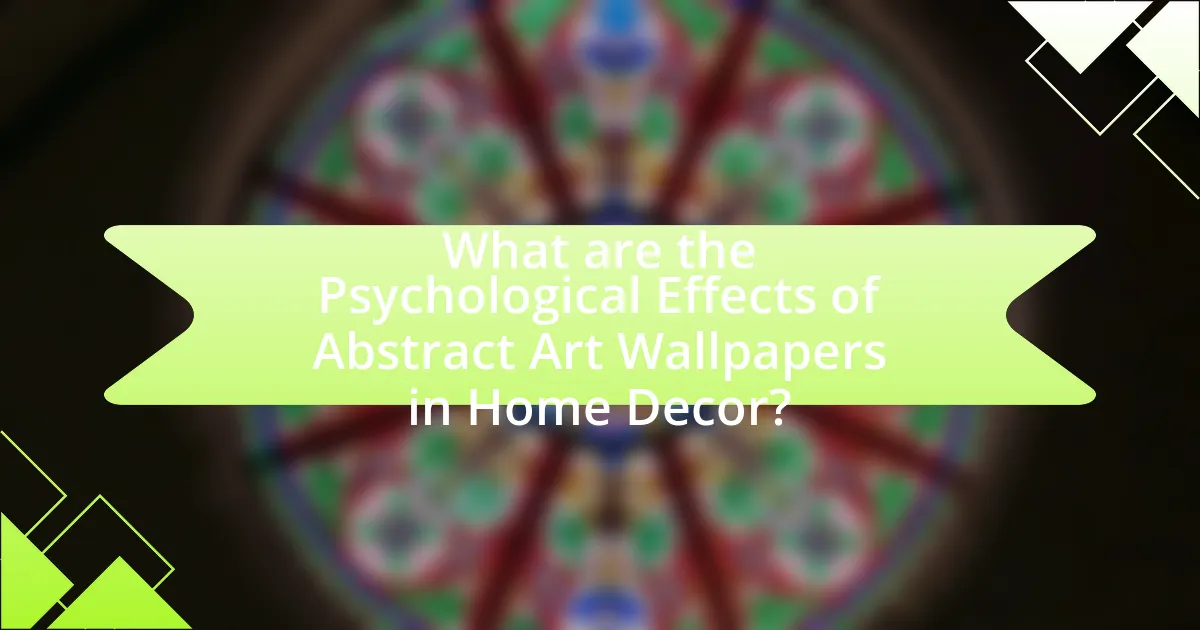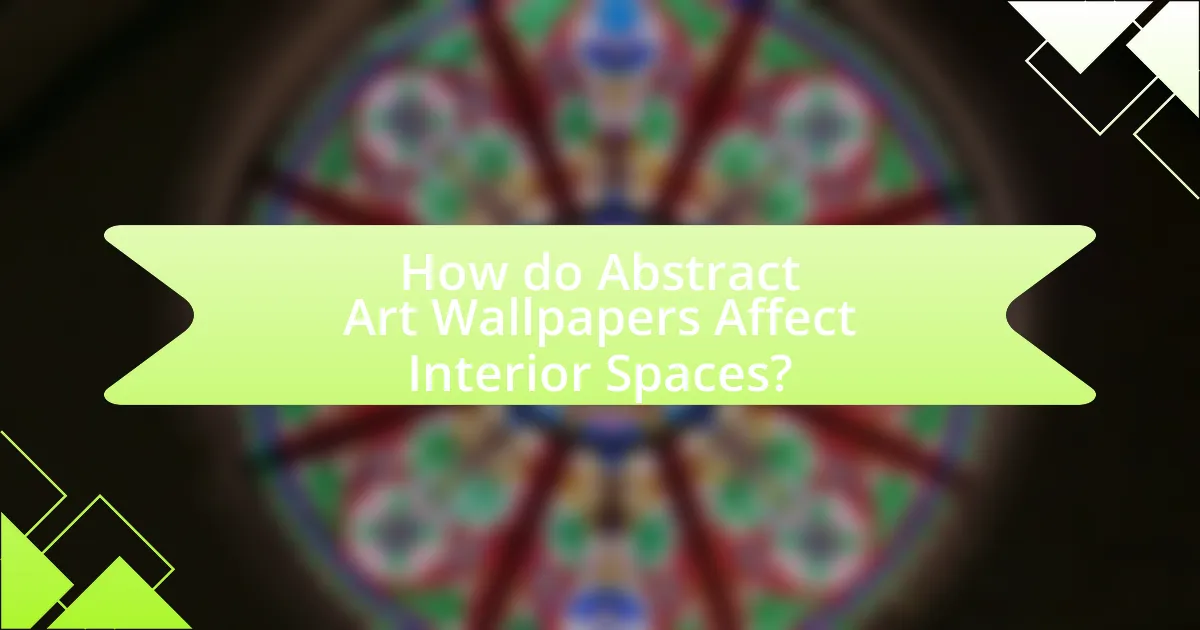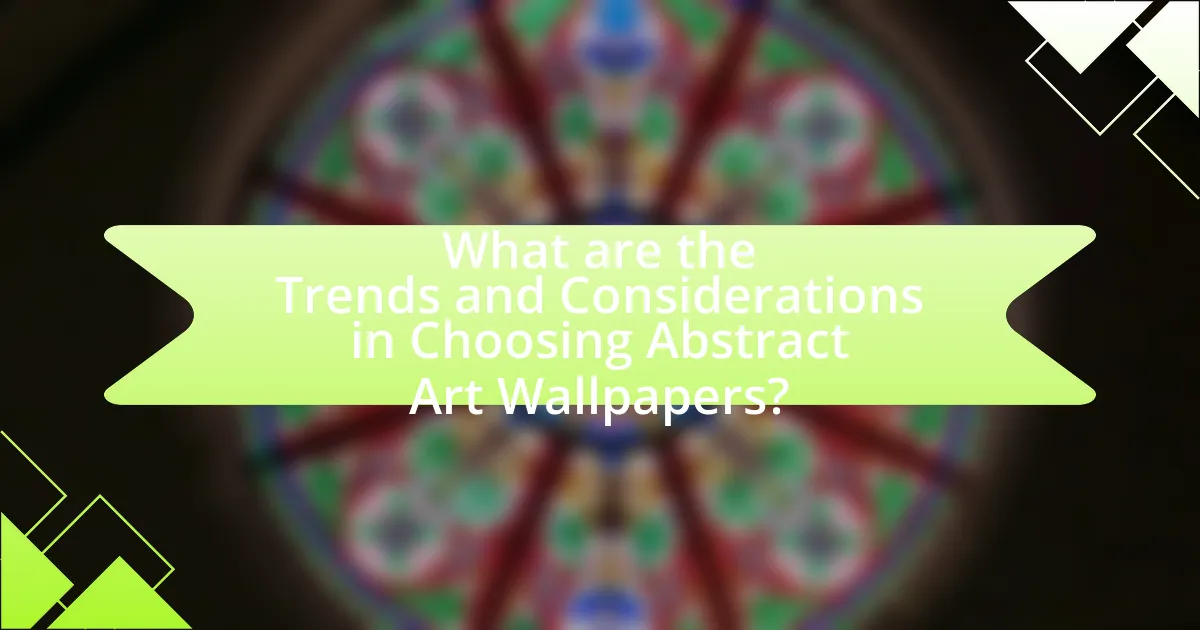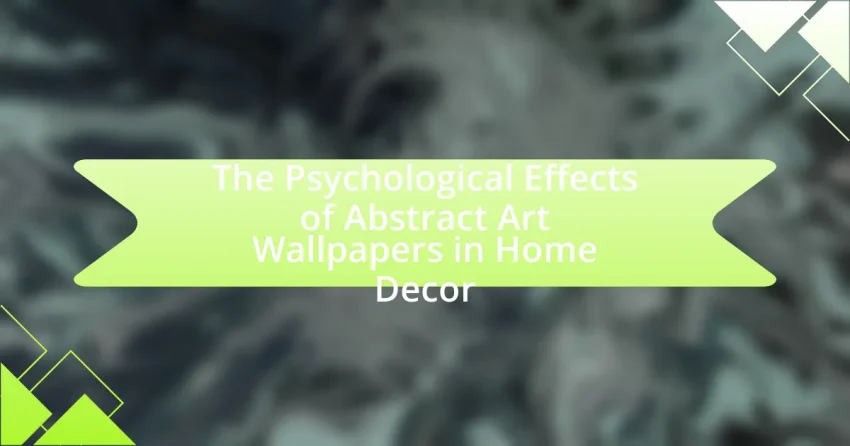The article examines the psychological effects of abstract art wallpapers in home decor, highlighting their ability to enhance creativity, evoke emotional responses, and create a calming atmosphere. It discusses how different styles and colors of abstract art influence mood and emotions, with research indicating that exposure to such art can lead to increased happiness and relaxation. The article also explores the psychological needs fulfilled by abstract art, the impact of personal taste on art selection, and the potential negative effects of confusing or overwhelming designs. Additionally, it provides insights into best practices for integrating abstract art into home decor, considering factors like color theory, scale, and lighting to optimize the emotional and aesthetic experience of interior spaces.

What are the Psychological Effects of Abstract Art Wallpapers in Home Decor?
Abstract art wallpapers in home decor can evoke a range of psychological effects, including enhanced creativity, emotional stimulation, and a sense of tranquility. Research indicates that exposure to abstract art can stimulate the brain’s creative processes, encouraging innovative thinking and problem-solving. For instance, a study published in the journal “Psychology of Aesthetics, Creativity, and the Arts” found that individuals exposed to abstract art reported higher levels of creative thinking compared to those who viewed representational art. Additionally, abstract art can elicit emotional responses, allowing individuals to connect with their feelings and experiences, which can lead to improved mental well-being. The use of vibrant colors and dynamic forms in abstract art can also create a calming atmosphere, reducing stress and promoting relaxation in living spaces.
How do abstract art wallpapers influence mood and emotions?
Abstract art wallpapers significantly influence mood and emotions by evoking feelings of creativity, tranquility, or stimulation. Research indicates that colors and forms in abstract art can trigger emotional responses; for instance, warm colors like red and orange may energize and excite, while cool colors like blue and green often promote calmness and relaxation. A study published in the Journal of Environmental Psychology found that individuals exposed to vibrant abstract art reported higher levels of happiness and creativity compared to those in neutral environments. This demonstrates that the visual elements of abstract art wallpapers can actively shape emotional experiences and enhance the overall atmosphere of a space.
What specific emotions are evoked by different styles of abstract art?
Different styles of abstract art evoke a range of specific emotions, including joy, confusion, tranquility, and anxiety. For instance, vibrant colors and dynamic shapes in abstract expressionism often elicit feelings of joy and excitement, as seen in the works of artists like Jackson Pollock. In contrast, minimalist abstract art, characterized by simplicity and muted tones, tends to evoke tranquility and calmness, as evidenced by the works of Donald Judd. Additionally, chaotic and fragmented forms in certain abstract styles can provoke confusion or anxiety, reflecting the emotional turmoil of the viewer. Research indicates that color theory plays a significant role in these emotional responses, with warm colors typically associated with positive emotions and cool colors linked to more subdued feelings.
How does color theory play a role in the psychological impact of abstract art?
Color theory significantly influences the psychological impact of abstract art by determining how colors evoke emotions and perceptions. Different colors can trigger specific psychological responses; for instance, warm colors like red and orange often elicit feelings of warmth and excitement, while cool colors like blue and green tend to promote calmness and tranquility. Research indicates that color can affect mood and behavior, with studies showing that environments featuring certain colors can enhance creativity or relaxation. For example, a study published in the journal “Color Research and Application” by researchers Andrew Elliot and Markus Maier found that red can enhance attention to detail, while blue can foster creativity. Thus, the application of color theory in abstract art can profoundly shape viewers’ emotional experiences and interpretations, making it a crucial element in the design of abstract art wallpapers for home decor.
Why do people choose abstract art wallpapers for their homes?
People choose abstract art wallpapers for their homes primarily because they evoke emotional responses and stimulate creativity. Abstract art allows for personal interpretation, enabling individuals to connect with the artwork on a deeper level, which can enhance the ambiance of a space. Research indicates that exposure to abstract art can lead to increased feelings of relaxation and inspiration, making it a popular choice for home decor. Additionally, abstract designs can complement various interior styles, providing versatility and a modern aesthetic that appeals to many homeowners.
What psychological needs do abstract art wallpapers fulfill?
Abstract art wallpapers fulfill psychological needs such as self-expression, emotional release, and cognitive stimulation. These wallpapers allow individuals to express their identity and personal taste, creating a sense of ownership and connection to their space. Research indicates that engaging with abstract art can evoke emotional responses, providing a therapeutic outlet for stress and anxiety. Additionally, the complexity and ambiguity of abstract designs stimulate cognitive engagement, encouraging creativity and imaginative thinking. This aligns with findings from studies on art therapy, which highlight the positive impact of visual art on mental well-being and emotional health.
How does personal taste in art reflect individual psychology?
Personal taste in art reflects individual psychology by revealing underlying personality traits, emotional states, and cognitive preferences. Research indicates that individuals often select art that resonates with their personal experiences and emotional needs, suggesting a connection between art preferences and psychological profiles. For instance, studies have shown that people who prefer abstract art may exhibit higher levels of openness to experience, while those who favor representational art might display more conventional traits. This correlation is supported by findings from the Journal of Personality and Social Psychology, which highlight how art preferences can serve as indicators of personality dimensions, thereby linking aesthetic choices to psychological characteristics.
What are the potential negative effects of abstract art wallpapers?
Abstract art wallpapers can lead to feelings of confusion or anxiety in some individuals due to their non-representational nature. The lack of recognizable forms may overwhelm viewers, causing discomfort or distraction, particularly in spaces meant for relaxation or focus. Research indicates that environments with chaotic or overly stimulating visuals can increase stress levels, as noted in a study published in the Journal of Environmental Psychology, which found that complex visual stimuli can hinder cognitive performance and emotional well-being.
Can abstract art cause feelings of confusion or discomfort?
Yes, abstract art can cause feelings of confusion or discomfort. This phenomenon occurs because abstract art often lacks clear representation, which can lead to varied interpretations and emotional responses. Research indicates that viewers may experience confusion when confronted with non-representational forms, as their brains seek familiar patterns and meanings. A study published in the journal “Psychology of Aesthetics, Creativity, and the Arts” by Silvia Knobloch-Westerwick and colleagues found that abstract artworks can evoke a range of emotions, including discomfort, due to their ambiguous nature.
How do different viewers interpret abstract art differently?
Different viewers interpret abstract art differently based on their personal experiences, cultural backgrounds, and emotional states. Research indicates that individual psychological factors, such as mood and personality traits, significantly influence how one perceives and connects with abstract art. For instance, a study published in the journal “Psychology of Aesthetics, Creativity, and the Arts” by Silvia and Nusbaum found that individuals with higher openness to experience tend to derive more meaning from abstract artworks compared to those with lower openness. Additionally, cultural context plays a crucial role; viewers from different cultural backgrounds may associate distinct meanings and emotions with the same artwork, leading to varied interpretations. This variability underscores the subjective nature of art appreciation, where personal and contextual factors shape the viewer’s understanding and emotional response to abstract art.

How do Abstract Art Wallpapers Affect Interior Spaces?
Abstract art wallpapers significantly influence interior spaces by altering perceptions and emotional responses. These wallpapers can create a sense of depth and movement, which can enhance the overall ambiance of a room. Research indicates that abstract art stimulates creativity and encourages open-mindedness, making spaces feel more dynamic and inviting. For instance, a study published in the Journal of Environmental Psychology found that environments featuring abstract art can lead to increased feelings of relaxation and inspiration among occupants. This effect is attributed to the non-representational nature of abstract art, which allows for personal interpretation and emotional engagement, ultimately transforming the atmosphere of interior spaces.
What role does abstract art play in enhancing or detracting from a room’s atmosphere?
Abstract art significantly enhances a room’s atmosphere by stimulating emotional responses and encouraging personal interpretation. The use of vibrant colors and dynamic forms in abstract art can create a sense of energy and movement, making a space feel more lively and engaging. Research indicates that exposure to abstract art can evoke feelings of joy and inspiration, contributing positively to the overall ambiance of a room. Conversely, poorly chosen abstract art can detract from a room’s atmosphere if it clashes with the existing decor or fails to resonate with the occupants, leading to feelings of discomfort or confusion. Thus, the impact of abstract art on a room’s atmosphere is contingent upon its alignment with the space’s aesthetic and the emotional needs of its inhabitants.
How can abstract art wallpapers create a sense of space or depth?
Abstract art wallpapers can create a sense of space or depth by utilizing color gradients, geometric shapes, and layered textures. These design elements can trick the eye into perceiving a three-dimensional space on a two-dimensional surface. For instance, the use of lighter colors in the foreground and darker shades in the background can simulate depth, while overlapping shapes can suggest layers, enhancing the illusion of space. Research indicates that visual perception is influenced by these artistic techniques, as they engage the viewer’s imagination and spatial awareness, making a room feel larger or more dynamic.
What are the best practices for integrating abstract art into home decor?
To effectively integrate abstract art into home decor, select pieces that resonate with the room’s color palette and overall theme. This alignment enhances visual harmony and creates a cohesive atmosphere. For instance, a bold abstract painting can serve as a focal point in a neutral room, drawing attention and adding depth. Additionally, consider the scale of the artwork; larger pieces work well in spacious areas, while smaller works can be grouped to create an impactful gallery wall. Research indicates that art can influence mood and perception, with abstract art often evoking emotional responses that enhance the living environment. Therefore, choosing art that reflects personal taste and emotional resonance can significantly improve the psychological ambiance of a space.
How do abstract art wallpapers interact with other design elements?
Abstract art wallpapers interact with other design elements by creating a dynamic visual dialogue that enhances the overall aesthetic of a space. These wallpapers can serve as focal points, drawing attention and influencing the color palette and texture choices of surrounding furnishings and decor. For instance, a bold abstract wallpaper can inspire complementary color schemes in furniture and accessories, while its patterns can harmonize with or contrast against other design elements, such as rugs or artwork. Research indicates that the use of abstract art in interior design can evoke emotional responses, thereby affecting how individuals perceive and experience their environment, as noted in studies on color psychology and spatial perception.
What types of furniture and decor complement abstract art wallpapers?
Furniture and decor that complement abstract art wallpapers include minimalist furniture, neutral-toned pieces, and geometric decor. Minimalist furniture, such as sleek sofas and simple coffee tables, allows the vibrant colors and complex patterns of abstract art to stand out without overwhelming the space. Neutral-toned pieces, like beige or gray chairs, provide a calming backdrop that enhances the visual impact of the wallpaper. Geometric decor, including angular vases or sculptural elements, echoes the shapes often found in abstract art, creating a cohesive aesthetic. This combination not only highlights the artwork but also fosters a balanced and harmonious environment, enhancing the overall psychological effect of the decor.
How can lighting influence the perception of abstract art in a room?
Lighting significantly influences the perception of abstract art in a room by altering the visibility, color interpretation, and emotional response to the artwork. Different lighting conditions, such as natural light versus artificial light, can enhance or diminish the vibrancy of colors, affecting how viewers interpret the piece. For instance, studies have shown that warm lighting can evoke feelings of comfort and intimacy, while cool lighting may create a more detached or analytical atmosphere. Additionally, the angle and intensity of light can create shadows and highlights that change the visual dynamics of the artwork, leading to varied interpretations. This interplay between light and art is crucial, as it shapes the viewer’s emotional and psychological engagement with the piece, ultimately influencing their overall experience in the space.

What are the Trends and Considerations in Choosing Abstract Art Wallpapers?
Trends in choosing abstract art wallpapers include a preference for bold colors, geometric patterns, and organic shapes that evoke emotional responses. These elements are popular because they can enhance the aesthetic appeal of a space while also influencing mood and perception. Considerations when selecting these wallpapers involve understanding the psychological impact of colors and patterns; for instance, warm colors can create a sense of comfort, while cooler tones may promote tranquility. Additionally, the scale of the artwork should match the size of the room to avoid overwhelming or underwhelming the space. Research indicates that environments featuring abstract art can stimulate creativity and reduce stress, making it essential to choose designs that resonate personally with the inhabitants.
What current trends are shaping the use of abstract art in home decor?
Current trends shaping the use of abstract art in home decor include a focus on personalization, sustainability, and the integration of technology. Personalization is evident as consumers increasingly seek unique pieces that reflect their individual tastes, often opting for custom artworks. Sustainability is influencing choices, with many artists and manufacturers using eco-friendly materials and practices, appealing to environmentally conscious buyers. Additionally, technology is playing a role, as digital art and augmented reality applications allow for interactive experiences and the ability to visualize art in various settings before purchase. These trends are supported by market research indicating a growing demand for personalized and sustainable home decor options, as well as the increasing popularity of digital platforms for art sales.
How do cultural influences affect the popularity of certain abstract art styles?
Cultural influences significantly affect the popularity of certain abstract art styles by shaping aesthetic preferences and artistic movements. For instance, the rise of abstract expressionism in the mid-20th century in the United States was heavily influenced by the cultural context of post-World War II, where artists sought to express individualism and emotional depth, reflecting societal changes. Additionally, global cultural exchanges have led to the incorporation of diverse techniques and themes in abstract art, making styles like Japanese ink painting or African tribal art increasingly popular in Western contexts. This blending of cultural elements not only enhances the appeal of specific abstract styles but also drives their acceptance and integration into contemporary home decor, as seen in the growing trend of using abstract art wallpapers that resonate with various cultural narratives.
What are the emerging themes in abstract art wallpapers for home decor?
Emerging themes in abstract art wallpapers for home decor include organic shapes, vibrant color palettes, and minimalistic designs. Organic shapes often evoke a sense of fluidity and connection to nature, which can enhance feelings of tranquility in living spaces. Vibrant color palettes are increasingly popular as they stimulate energy and creativity, making them suitable for areas like home offices or playrooms. Minimalistic designs focus on simplicity and negative space, promoting a sense of calm and clarity, which is beneficial in bedrooms or meditation areas. These themes reflect current trends in interior design that prioritize emotional well-being and aesthetic appeal.
How can homeowners select the right abstract art wallpaper for their space?
Homeowners can select the right abstract art wallpaper for their space by considering the color palette, scale, and emotional impact of the artwork. The color palette should complement existing decor and create a cohesive look, while the scale of the wallpaper must fit the dimensions of the room to avoid overwhelming or underwhelming the space. Additionally, homeowners should assess the emotional response elicited by the artwork, as studies indicate that colors and patterns can significantly influence mood and perception. For instance, a study published in the Journal of Environmental Psychology found that colors like blue can evoke calmness, while vibrant colors like red can stimulate energy. By aligning these factors with personal preferences and the intended atmosphere of the room, homeowners can effectively choose abstract art wallpaper that enhances their living environment.
What factors should be considered when choosing colors and patterns?
When choosing colors and patterns, consider psychological effects, cultural significance, and the intended mood of the space. Colors can evoke specific emotions; for example, blue often promotes calmness, while red can stimulate energy. Patterns can influence perception of space; larger patterns may make a room feel smaller, while smaller patterns can create a sense of openness. Cultural significance also plays a role, as certain colors and patterns may have different meanings in various cultures, impacting the viewer’s emotional response. Research indicates that color choices can affect mood and behavior, with studies showing that environments designed with mindful color palettes can enhance well-being and productivity.
How can homeowners assess the psychological impact of their choices?
Homeowners can assess the psychological impact of their choices by reflecting on their emotional responses to different decor elements, such as abstract art wallpapers. This involves observing changes in mood, stress levels, and overall well-being after implementing these design choices. Research indicates that colors and patterns in art can evoke specific emotions; for instance, vibrant colors may enhance feelings of happiness, while darker tones might induce calmness or introspection. By keeping a journal to track these emotional responses over time, homeowners can gain insights into how their decor choices influence their mental state, thereby allowing for informed adjustments to their living spaces.
What practical tips can help in the effective use of abstract art wallpapers?
To effectively use abstract art wallpapers, select designs that resonate with the room’s purpose and mood. For instance, calming colors and fluid shapes can enhance relaxation in bedrooms, while vibrant patterns may energize a workspace. Additionally, consider the scale of the artwork; larger pieces can serve as focal points, while smaller designs can complement existing decor. Proper lighting is crucial; natural light can enhance the colors and textures of the wallpaper, making the space feel more inviting. Lastly, ensure that the wallpaper harmonizes with other elements in the room, such as furniture and accessories, to create a cohesive aesthetic. These strategies leverage the psychological impact of abstract art, promoting emotional well-being and enhancing the overall atmosphere of the home.
